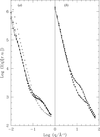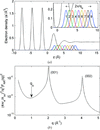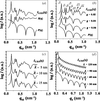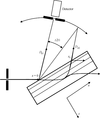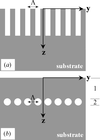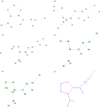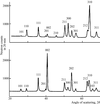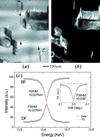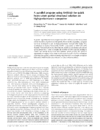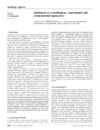issue contents
April 2007 issue

Cover illustration: Molecular electrostatic potential of thymidine mapped on the charge density isosurface at 0.5 e Å-3 using MolIso. Courtesy of C. B. Huebschle & P. Luger [J. Appl. Cryst. (2006), 39, 901-904].
research papers
The efficiencies of Patterson and direct-methods techniques for substructure applications are compared.
Energy-dispersive small-angle X-ray scattering experiments on protein solutions, micelles, semicrystalline polymers and metal oxides are discussed to illustrate the limits and the potentialities of this technique.
X-ray powder diffraction and synchrotron radiation have been used to determine the lattice parameter of the NIST standard reference material (SRM 660) LaB6 as 4.156468 Å with an accuracy of 12 parts per million (p.p.m.), calibrated relative to the lattice parameter of the Si powder standard [a0 = 5.430940 (11) Å, Si 640b]. A discrepancy of 0.00048 (5) Å, or nine standard deviations from the NIST reference, is observed between the currently accepted lattice spacing of LaB6 and the measured value.
Asymmetry in the intensity of the reflections of Bijvoet pairs in a symmetrical zone axis is compared with that of a computer-simulated CBED pattern. The method has been successfully applied to crystals belonging to the point groups 321 and 312.
The resolution of small-angle neutron scattering instruments is investigated for the case where refractive optics (lenses or prisms) are used. The appropriate equations are derived to describe the position and the spatial variance of the neutron beam at the detector in the horizontal and vertical directions, and the minimum value of the scattering vector.
The crystalline microstructure of mullites, produced by heating monophasic gels, prepared from mixtures of aluminium nitrate and tetraethylorthosilicate, at different final treatment temperatures, is characterized by prevalent crystallite shape, volume-weighted crystallite size distribution and second-order crystalline lattice strain distribution determined from X-ray diffraction patterns. These characteristics, being dependent on process temperature and initial gel chemical composition, are in good agreement with images obtained from field emission scanning electron microscopy and transmission electron microscopy.
The anisotropy of the NH4Cl crystallite zigzag aggregation pattern is a twin structure of 6mm symmetry, related to the crystal point group m3m. The twin axis is [110], the twin plane is {211} and the contact interface is {411}.
After deriving the linear relations among the scattering intensities of samples related by slight modifications, we characterize the fluid extraction process of coal.
A model-independent formalism to obtain element-specific partial structures at buried interfaces using resonant anomalous X-ray scattering is described. The amplitude and phase of an element-specific partial structure factor, obtained with resonant anomalous X-ray reflectivity spectra, allow unknown element-specific partial density distributions at an interface having an arbitrary shape to be reconstructed by discrete Fourier synthesis.
The small-angle scattering structure functions of the single spherical half-shell (SHS) are discussed based on the chord length distribution of the so-called cap chords of a solid hemisphere. Using simple analytic expressions, it is possible to describe the scattering of polydisperse arrangements of non-interacting SHSs.
This paper demonstrates a quantitative, nondestructive analysis of nanostructured thin films supported on substrates and their templated nanopores with grazing incidence X-ray scattering.
A stochastic algorithm is presented for the reconstruction of two-dimensional grain maps of embedded layers in moderately deformed polycrystalline specimens based on X-ray diffraction.
Exact and approximate equations are derived which can be used to simulate dynamical scattering artifacts (mirage peaks) that are observed in diffraction from strained single crystals.
A laboratory X-ray diffractometer devoted to the in situ characterization of the microstructure of epitaxic thin films at temperatures up to 1500 K has been built. A specific stage for the in situ correction of the sample holder dilation allows accurate sample positioning over the whole temperature range explored.
By analysis of transverse and longitudinal scans in the reciprocal space, both crossing a selected reciprocal lattice point, the shape, size and lateral gap of empty channels, distributed as a one-dimensional periodic array below the surface of silicon-on-nothing architectures, were determined thanks to the high-resolution optics adopted for the measurements.
A procedure is described aiming at recovering a complete crystal structure from a uninterpretable electron density map produced by application of direct methods to powder data.
The orientation of the mineral crystals of a fractured tibia bone of a sheep is not restored after almost two years of recovery.
Rietveld analysis of the X-ray diffraction pattern and electron back-scattered diffraction studies are presented for the structure and microstructure evolution during γfcc → ∊hcp martensitic transformation due to various cooling conditions of wrought austenitic steel.
The anisotropic microstrain distribution resulting from an isotropic distribution of a field tensor (rank 0 or 2), the latter being connected with strain by an anisotropic property tensor (rank 2 or 4), is analyzed. The treatment simplifies the search for a possible physical origin of experimentally observed anisotropic microstrain broadening.
short communications
A sharp inequality is proved between the  -norm and the entropy of probability density functions; this inequality is applied to texture analysis by characterizing the relationship between the entropy and the texture index of an orientation density function. The relationship is empirically verified with simulated and experimental data.
-norm and the entropy of probability density functions; this inequality is applied to texture analysis by characterizing the relationship between the entropy and the texture index of an orientation density function. The relationship is empirically verified with simulated and experimental data.
An extension of the recently developed X-ray bright-field imaging technique is presented that allows the quantitative analysis of crystalline quality parameters such as the lattice plane curvature and the mosaic distribution in SiC wafers.
Download citation


Download citation


A new method for the reproducible generation of polymorphs, `potentiometric cycling for polymorph creation (PC)2', is described. This new method has been applied to sulindac, a non-steroidal anti-inflammatory drug, which also shows promise in anticancer treatment, producing two polymorphs of this API, including a new more stable one.
CIF applications
Free 

Crystal morphologies are predicted from data stored in files in CIF format on the basis of the Bravais–Friedel, Donnay–Harker model.
computer programs
The Fortran90 source code of the program PSILAM has been deposited with the IUCr.
Based on a parallel algorithm designed for SHELXD to solve the heavy-atom partial structures of protein crystals quickly, a program has been developed to run on high-performance multiple-CPU Linux PCs, workstations or clusters.
laboratory notes
A model of an air cooler in a laboratory furnace, for simultaneous regulation of different crystallization fronts and rates in crucible columns, with the purpose of obtaining crystals, is presented.
meeting reports
Free 

A report on the VIZIER Workshop on the `Definition of protein domains and their likelihood of crystallization', Vienna, Austria, 28–30 June 2006.


 journal menu
journal menu















